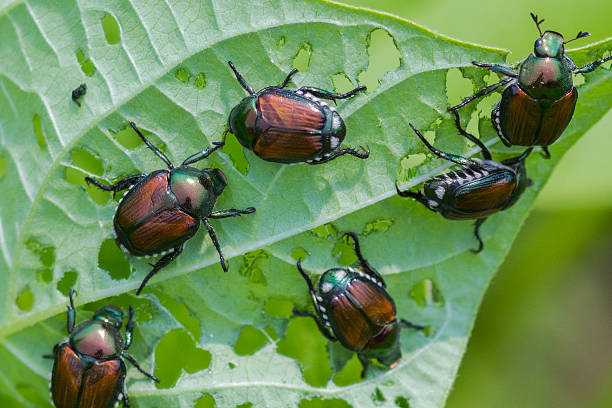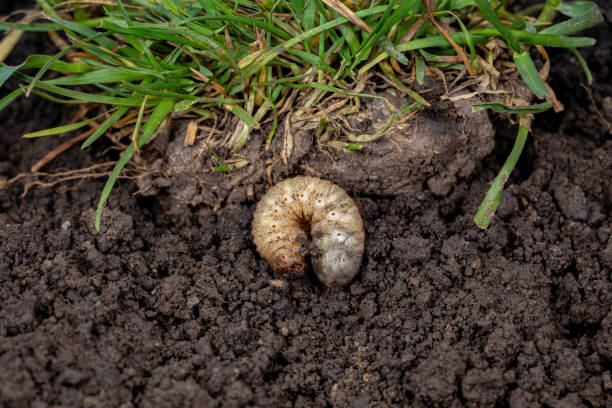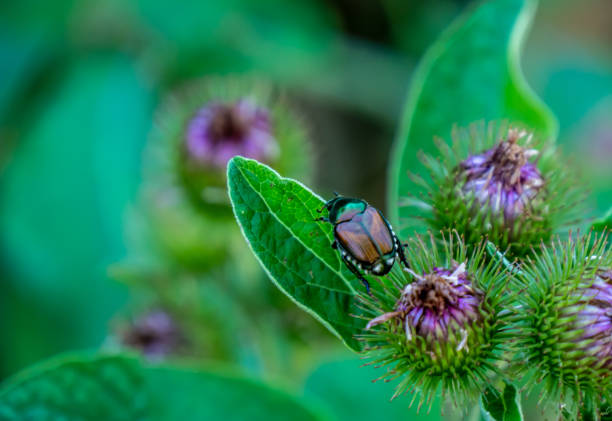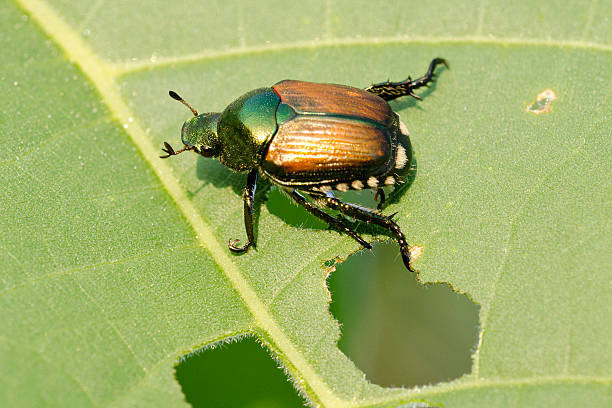Complete Guide to Japanese Beetles: Identification, Control, and Prevention (2025)
Looking for definitive information about Japanese Beetles? This comprehensive guide covers everything you need to know about identifying, controlling, and preventing Japanese Beetle (Popillia japonica) infestations. Whether you’re a home gardener, farmer, or landscape professional, understanding these destructive pests is crucial for protecting your plants and maintaining healthy gardens.
Quick Facts About Japanese Beetles
- Scientific Name: Popillia japonica
- Adult Size: 3/8 to 1/2 inch long
- Distinctive Features: Metallic green body, copper-brown wing covers
- Active Season: Late May through August (varies by region)
- Damage Type: Skeletonization of leaves, flower destruction
- Host Plants: Over 300 species including roses, grapes, and fruit trees
- Distribution: Throughout eastern and central United States
- Life Span: Adults live 30-50 days
Historical Background and Invasion Timeline
The Japanese Beetle’s journey from Asia to North America represents one of the most significant invasive species events in U.S. agricultural history. Here’s a detailed timeline of their invasion:
- Pre-1912: Japanese Beetles were confined to Japan, where natural predators kept populations in check
- 1916: First documented discovery in New Jersey
- 1919: Recognition as an established pest in the United States
- 1930s: Rapid spread throughout the eastern United States
- 1950s: Establishment in Midwest regions
- Present Day: Found in most states east of the Mississippi River
Comprehensive Identification Guide

Adult Beetle Characteristics
- Head and Thorax:
- Brilliant metallic green coloration
- Highly reflective surface
- Distinctive armor-like appearance
- Wing Covers (Elytra):
- Copper-brown coloration
- Metallic sheen
- Slightly shorter than abdomen
- Distinguishing Features:
- Five white hair tufts along each side of abdomen
- Two white tufts at tip of abdomen
- Oval-shaped body structure
- Six spiny legs
Similar Species and How to Differentiate
Several beetles can be mistaken for Japanese Beetles. Here’s how to distinguish them:
| Look-alike Species | Key Differences |
|---|---|
| Green June Beetle | Larger size, solid green color, no white tufts |
| Rose Chafer | Tan/brown color, longer legs, slender body |
| Oriental Beetle | Darker coloring, different pattern, no metallic sheen |
Life Cycle and Development Stages

Complete Life Cycle Breakdown
- Egg Stage (July-August)
- Size: 1/16 inch, oval-shaped
- Color: Creamy white
- Location: 2-4 inches below soil surface
- Duration: 8-14 days
- Female beetles lay 40-60 eggs
- Larval Stage (August-June)
- Three distinct growth instars
- Size: 1/8 inch to 1 inch
- Characteristic C-shaped grub
- White body with brown head
- Feeds on grass roots and organic matter
- Pupal Stage (June-July)
- Duration: 1-3 weeks
- Color changes from cream to reddish-brown
- Located 2-6 inches below soil surface
- No feeding occurs during this stage
- Adult Stage (July-September)
- Emerges from soil in early summer
- Active for 4-6 weeks
- Most active during warm, sunny days
- Feeds on foliage and flowers
- Mating and egg-laying occurs during this period
Impact on Gardens and Agriculture: Understanding the Damage

Plant Damage Assessment
- Leaf Damage:
- Skeletonization (eating between leaf veins)
- Lace-like appearance of affected leaves
- Progressive defoliation from top of plant
- Brown, damaged tissue
- Flower Damage:
- Complete consumption of flower petals
- Destruction of flower buds
- Reduced blooming capacity
- Impact on ornamental value
- Root Damage (from larvae):
- Destruction of grass root systems
- Creation of dead patches in lawns
- Reduced drought tolerance in affected areas
- Increased susceptibility to turf pull-up
Economic Impact
- Agricultural Losses:
- Annual crop damage estimated at $460 million
- Additional $156 million spent on control measures
- Significant impact on fruit and vegetable production
- Reduced crop yields and quality
- Landscape Industry Impact:
- Increased maintenance costs
- Plant replacement expenses
- Additional labor for control measures
- Customer satisfaction challenges
Comprehensive Control Methods
Chemical Control Options
| Control Type | Active Ingredients | Application Timing | Effectiveness |
|---|---|---|---|
| Systemic Insecticides | Imidacloprid, Thiamethoxam | Early Spring | 4-8 weeks protection |
| Contact Sprays | Pyrethrin, Carbaryl | At first sight of beetles | 2-7 days protection |
| Grub Control | Halofenozide, Trichlorfon | Late Summer | Season-long control |
Natural and Organic Control Methods
- Biological Controls:
- Milky Spore Disease:
- Natural bacteria affecting grubs
- Long-term protection (10+ years)
- Best applied in late summer
- Requires soil temperature above 65°F
- Beneficial Nematodes:
- Species: Heterorhabditis bacteriophora
- Application in spring or fall
- Requires moist soil conditions
- Immediate grub control
- Milky Spore Disease:
- Physical Controls:
- Hand-Picking:
- Most effective in early morning
- Drop beetles in soapy water
- Regular monitoring required
- Labor-intensive but effective
- Row Covers:
- Physical barrier protection
- Must be removed for pollination
- Effective for valuable plants
- Regular inspection needed
- Hand-Picking:
Comprehensive Prevention Strategies
Landscape Planning and Plant Selection
- Resistant Plant Species:
- Trees:
- Red Maple (Acer rubrum)
- Dogwood (Cornus species)
- Northern Red Oak (Quercus rubra)
- Magnolia varieties
- Shrubs:
- Boxwood (Buxus species)
- Holly (Ilex species)
- Lilac (Syringa species)
- Red Twig Dogwood
- Perennials:
- Coral Bells (Heuchera)
- Foxglove (Digitalis)
- Lantana species
- Russian Sage
- Trees:
Cultural Control Methods
- Lawn Management:
- Maintain grass height at 3 inches
- Reduce irrigation during beetle egg-laying period
- Proper fertilization timing
- Regular soil aeration
- Soil Management:
- Regular pH testing (maintain 6.5-7.0)
- Organic matter incorporation
- Proper drainage maintenance
- Compaction prevention
Environmental Considerations and Ecosystem Impact
Impact on Local Ecosystems
- Beneficial Insects:
- Effects on native pollinators
- Impact on predatory insects
- Competition with native species
- Disruption of natural balance
- Soil Ecosystem:
- Changes in soil microorganism populations
- Impact on earthworm communities
- Root system damage effects
- Soil structure alterations
Environmental-Friendly Control Methods
| Method | Environmental Impact | Effectiveness | Best Practices |
|---|---|---|---|
| Companion Planting | Positive | Moderate | Plant catnip, garlic, tansy near vulnerable plants |
| Beneficial Insects | Positive | Long-term | Introduce spring tiphia wasps, tachinid flies |
| Natural Repellents | Minimal | Short-term | Use neem oil, garlic spray, essential oils |
Regional Management Approaches
Climate-Based Control Strategies
- Northern Regions (Zones 3-5):
- Shorter control window
- Focus on spring preparation
- Extended grub control period
- Winter protection strategies
- Central Regions (Zones 6-7):
- Balanced approach needed
- Multiple control cycles
- Year-round monitoring
- Integrated pest management
- Southern Regions (Zones 8-10):
- Extended control season
- Multiple generations possible
- Increased monitoring needed
- Adaptation to local conditions
Seasonal Control Calendar
Spring (March-May)
- Early Spring:
- Soil testing
- Grub monitoring
- Prevention planning
- Plant protection preparation
- Late Spring:
- Begin monitoring for adult emergence
- Set up early warning systems
- Prepare control materials
- Implement prevention strategies
Summer (June-August)
- Early Summer Activities:
- Daily monitoring for first beetle emergence
- Implementation of hand-picking routines
- Application of preventive sprays
- Installation of protective barriers
- Mid-Summer Tasks:
- Peak beetle control measures
- Regular inspection of traps
- Documentation of damage patterns
- Adjustment of control strategies
- Late Summer Focus:
- Grub control applications
- Soil moisture management
- Assessment of plant damage
- Planning for fall treatments
Fall (September-November)
- Early Fall:
- Secondary grub treatments
- Soil preparation for winter
- Removal of damaged plant material
- Documentation of seasonal patterns
- Late Fall:
- Final lawn treatments
- Winter preparation measures
- Protection of vulnerable plants
- Equipment cleaning and storage
Winter (December-February)
- Winter Management:
- Planning for next season
- Equipment maintenance
- Educational preparation
- Supply ordering
- Record Keeping:
- Analysis of previous year’s data
- Strategy adjustment for coming season
- Budget planning for controls
- Research on new control methods
Frequently Asked Questions (FAQs)
General Questions
Q: How long do Japanese Beetles live?
A: Adult Japanese Beetles typically live for 30-50 days. However, their entire life cycle from egg to adult spans about one year.
Q: Do Japanese Beetles bite humans?
A: While Japanese Beetles can grip firmly with their legs, they don’t bite humans. Their mouth parts are designed for chewing plant material, not for biting people.
Q: Are Japanese Beetle traps effective?
A: Japanese Beetle traps can be counterproductive as they often attract more beetles than they catch. They’re better used for monitoring populations rather than control.
Control and Prevention Questions
Q: What is the most effective natural control method?
A: A combination of hand-picking beetles in the morning, using neem oil sprays, and maintaining healthy soil with beneficial nematodes provides the most effective natural control.
Q: How can I protect my roses from Japanese Beetles?
A: Protect roses through:
- Regular morning inspection and hand-picking
- Use of fine mesh netting during peak season
- Application of neem oil or pyrethrin-based sprays
- Planting resistant varieties nearby as decoys
Expert Tips and Recommendations
Professional Insights
- Timing is Critical:
- Begin monitoring 2-3 weeks before expected emergence
- Apply controls at first sight of beetles
- Coordinate with neighbors for community-wide control
- Integrated Approach:
- Combine multiple control methods
- Rotate control products to prevent resistance
- Focus on long-term prevention
Resources and Further Reading
Scientific Research
- University Extension Publications
- Agricultural Research Service Studies
- Integrated Pest Management Guides
- State-Specific Control Recommendations
Useful Tools and Products
| Tool Category | Recommended Uses | Maintenance Tips |
|---|---|---|
| Monitoring Equipment | Population tracking, damage assessment | Regular cleaning, proper storage |
| Application Tools | Precise treatment application | Calibration, cleaning after use |
| Protection Gear | Personal safety during treatment | Regular inspection, replacement schedule |
Troubleshooting Common Issues
Problem-Solving Guide
| Problem | Possible Causes | Solutions |
|---|---|---|
| Treatment Failure | Incorrect timing, wrong product | Review application schedule, verify product selection |
| Recurring Infestations | Incomplete control, neighboring populations | Expand treatment area, coordinate with neighbors |
| Resistant Populations | Overuse of single control method | Implement integrated approach, rotate controls |
Final Thoughts
Successfully managing Japanese Beetles requires a comprehensive, year-round approach combining multiple control strategies. Stay informed about new control methods and always adapt your approach based on local conditions and specific challenges. Remember that persistence and consistency are key to long-term success in Japanese Beetle control.






Leave a Reply